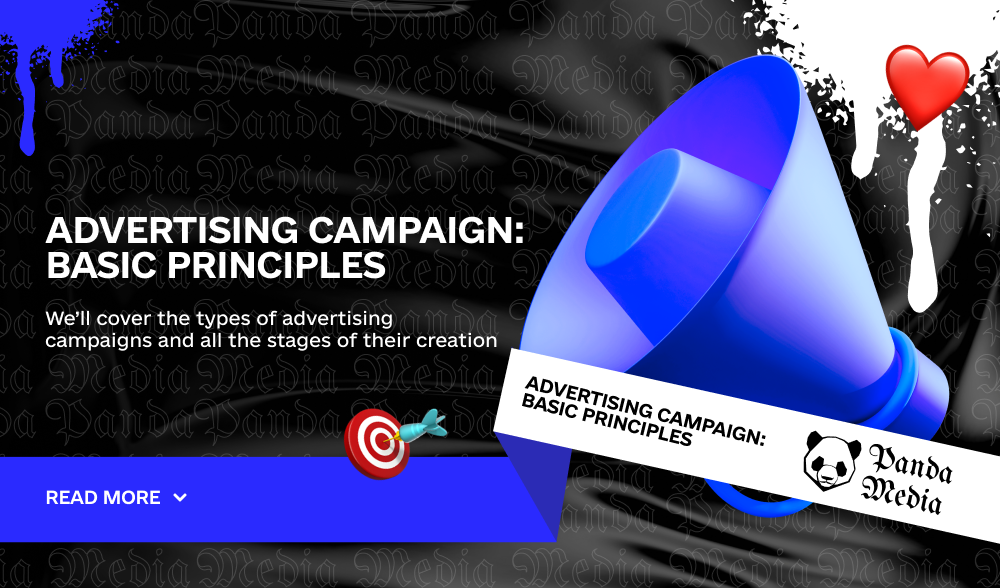An advertising campaign is a strategically planned series of advertising activities to increase attention to a product, service, or brand.
In online marketing, an advertising campaign is a group of ads in targeted or contextual advertising services.

Types of advertising campaigns
Advertising campaigns can be classified according to numerous criteria:
- By type of target audience – B2B, B2C;
- by duration – short-term (up to 1 month), medium-term (up to 6 months) and long-term (from six months);
- by the number of channels – complex (two or more) and simplex (one channel);
- by type of channels – online, offline.
Let’s take a closer look at the classifications by goals and geographic coverage.
By purpose
Image RKs are aimed at increasing awareness, and building brand reputation, trust, and loyalty. They are used to maintain audience interest, introduce a new brand to the market, or rebrand.
The product promotes a product or service. The main task is to tell the consumer about a new product, line, or model.
Trade incentives support sales, and motivate the client to make a purchase right now. The audience is already familiar with the brand or product. The company offers discounts or promotions to support demand.
In Internet marketing, a different classification is used for goals.
Outreach. Their task is to tell about the brand or product to the maximum number of people from the target audience. That is, to make more ad impressions, mentions, and views. Such campaigns help to increase brand awareness, increase audience loyalty to the product, and tell about new products, promotions, and changes.
Conversion. They encourage the user to take a targeted action: make a purchase, leave a request, subscribe, and register. Such works have a clear CTA and a call-to-action button.

By geography of coverage
Local advertising is aimed at a small group of people. For example, residents of one city, or neighborhood, visitors to a shopping center or event. Large companies use local campaigns to test concepts and creatives, and test launches of products or new formats.
Regional covers several cities or regions.
Federal is broadcast to the whole country. Suitable for promoting FMCG – everyday goods that can be bought in any region.
International takes place simultaneously in two or more countries. Usually, brands adapt their promotion strategy to each country, taking into account cultural and socio-political features.

Stages of an advertising campaign
Before launching an advertising campaign, you need to conduct positioning and branding. First, it is important to identify the benefits of the product, the pains and needs of the target audience, and come up with a name and logo.

The main stages of an advertising campaign are as follows:
Situation analysis:
Analyze the advertising activity of competitors. Find out where they place their ads, what promotions or products they promote, what formats they use, what price they sell at, and whether they involve stars and opinion leaders.
Study the target audience: what they know about the product, what opinion they have about the brand and competitors. It’s not always possible to conduct in-depth research, so it’s acceptable to formulate hypotheses in this regard. After that, segment your audience and formulate a unique selling proposition. You need to clearly understand what distinguishes your product from similar ones. This will help you create good creatives.
Setting a goal
The goal is determined by the market situation, current tasks, and the company’s development strategy. For example, to increase sales of seasonal goods, launch a new product, and improve brand reputation.
The goal should be specific, measurable, relevant, and time-bound. This approach to goal setting is called SMART.
A good goal is not “expanding the client base”, but “getting 20 applications for training by December 1”. Such a goal is easy to divide into tasks, define KPIs, and communicate to the performers.
Creating a concept
The creative stage of the process. Consider which image will best convey the main idea to the consumer. Brainstorm for interesting ideas. You can create in any niche – even serious banks launch unusual advertising campaigns.
Development of a media plan
A media plan is a document, usually in the form of a table, that contains key information about an advertising campaign: promotion channels, timing, formats, cost of placement, coverage, and other indicators.
The success of an advertising campaign depends on the choice of promotion channels. Without a suitable communication channel, the target audience will not see even the best creatives. In this case, the entire budget will be wasted.
When choosing channels, focus on three criteria:
- Audience quality. This is a set of socio-demographic characteristics (gender, age, income, interests) and engagement indicators (share of likes, reposts, comments, reactions). A channel’s audience rarely matches the product’s target audience by 100%. Therefore, it is important to evaluate not only the number of viewers or subscribers but also the share of your target audience among them.
- Relevance. Advertising should be relevant to the topic of the platform. Advertising of medical services on an entertainment blog is unlikely to be relevant, despite the presence of a target audience among subscribers.
- Reputation. This is a certain opinion that viewers or subscribers have about a blog, website, or channel.
Determine the media and placement formats, timing, and number of impressions. Calculate the budget and define performance indicators.
For online campaigns, use the main performance marketing metrics: CPA (cost per action), CAC (cost per acquisition), ROAS (return on advertising spend), and CPC (cost per click).
The results of offline events are evaluated by indirect indicators: the number of purchases, applications, store visitors, returned coupons and used promotional codes.
If the campaign is an image campaign, brand tracking is a good solution. It should be carried out before and after the launch of the campaign, and then compare the results and adjust the strategy if necessary.
Development of advertising materials
Based on the chosen concept, prepare a brief – a task for the performers who create advertising: designers, photographers, copywriters, and bloggers. Develop layouts for all designs and formats, videos, and other materials.
Before launching an ad campaign with a large reach and budget, test hypotheses and creatives on a small audience – conduct A/B testing.
To do this, prepare 2-3 variants of layouts or videos. Divide your audience into equal groups, show them different creatives, and measure the results. Choose the most effective layouts and use them for the main campaign.
Launch
At the launch stage, you need to buy and place ads. To meet the deadline, it is important to take into account the time for printing materials, installing structures, moderating, and checking ads.
The process can be entrusted to an agency or you can find individual contractors, for example, a targeting specialist for social media ads. If the company has enough in-house specialists, they will take care of the entire scope of work.
Campaign optimization
Analytics help to determine the most effective promotion channels, creatives, and audience segments. On platforms with poor performance, placement is terminated, the budget is optimized and redistributed in favor of more converting ones. If the audience did not receive the idea or brand message well, you need to adjust the creatives or try other audience segments.
Results analysis
At this stage, real and predicted KPI values are compared. It is necessary to calculate the metrics that were previously identified as key in the media plan and analyze their values.
The effectiveness of online advertising will be determined by end-to-end analytics. It will combine data from all advertising channels and show their effectiveness, taking into account the sales made.
Conclusion
Advertising campaign:
- This is a set of measures to attract consumer attention to a brand or product. They are united by a common idea and goal.
- According to the goals, there are image, product, and trade campaigns, in Internet marketing they are divided into outreach and conversion campaigns
- To launch an RC, you need to analyze the market, formulate goals, and develop a media plan
- It is important to track the results of the PPC to improve the strategy and reallocate the budget.



